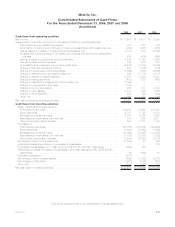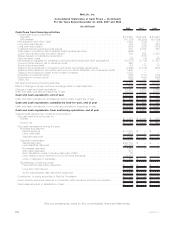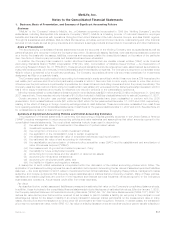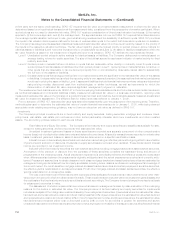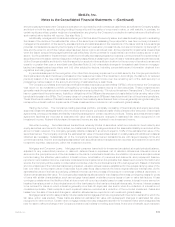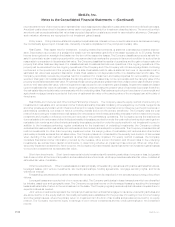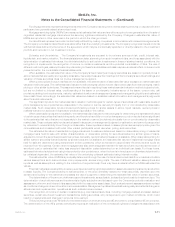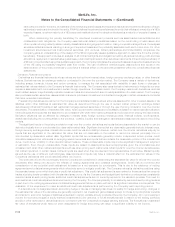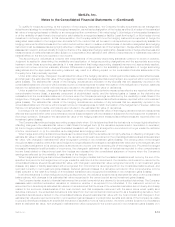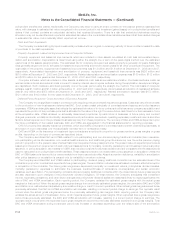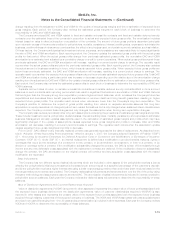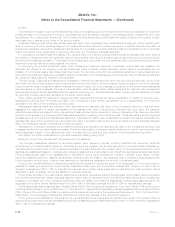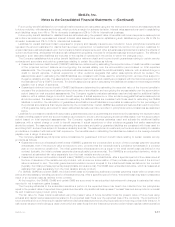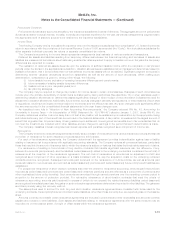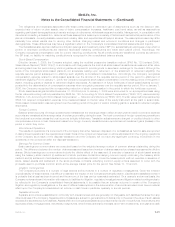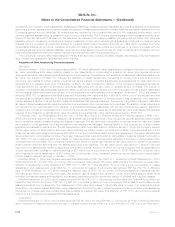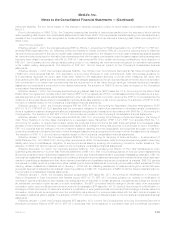MetLife 2008 Annual Report Download - page 138
Download and view the complete annual report
Please find page 138 of the 2008 MetLife annual report below. You can navigate through the pages in the report by either clicking on the pages listed below, or by using the keyword search tool below to find specific information within the annual report.change resulting from the adjustment to DAC and VOBA for the update of actual gross margins and the re-estimation of expected future
gross margins. Each period, the Company also reviews the estimated gross margins for each block of business to determine the
recoverability of DAC and VOBA balances.
The Company amortizes DAC and VOBA related to fixed and variable universal life contracts and fixed and variable deferred annuity
contracts over the estimated lives of the contracts in proportion to actual and expected future gross profits. The amortization includes
interest based on rates in effect at inception or acquisition of the contracts. The amount of future gross profits is dependent principally
upon returns in excess of the amounts credited to policyholders, mortality, persistency, interest crediting rates, expenses to administer the
business, creditworthiness of reinsurance counterparties, the effect of any hedges used, and certain economic variables, such as inflation.
Of these factors, the Company anticipates that investment returns, expenses, and persistency are reasonably likely to impact significantly
the rate of DAC and VOBA amortization. Each reporting period, the Company updates the estimated gross profits with the actual gross
profits for that period. When the actual gross profits change from previously estimated gross profits, the cumulative DAC and VOBA
amortization is re-estimated and adjusted by a cumulative charge or credit to current operations. When actual gross profits exceed those
previously estimated, the DAC and VOBA amortization will increase, resulting in a current period charge to earnings. The opposite result
occurs when the actual gross profits are below the previously estimated gross profits. Each reporting period, the Company also updates
the actual amount of business remaining in-force, which impacts expected future gross profits. When expected future gross profits are
below those previously estimated, the DAC and VOBA amortization will increase, resulting in a current period charge to earnings. The
opposite result occurs when the expected future gross profits are above the previously estimated expected future gross profits. Total DAC
and VOBA amortization during a particular period may increase or decrease depending upon the relative size of the amortization change
resulting from the adjustment to DAC and VOBA for the update of actual gross profits and the re-estimation of expected future gross profits.
Each period, the Company also reviews the estimated gross profits for each block of business to determine the recoverability of DAC and
VOBA balances.
Separate account rates of return on variable universal life contracts and variable deferred annuity contracts affect in-force account
balances on such contracts each reporting period which can result in significant fluctuations in amortization of DAC and VOBA. Returns
that are higher than the Company’s long-term expectation produce higher account balances, which increases the Company’s future fee
expectations and decreases future benefit payment expectations on minimum death and living benefit guarantees, resulting in higher
expected future gross profits. The opposite result occurs when returns are lower than the Company’s long-term expectation. The
Company’s practice to determine the impact of gross profits resulting from returns on separate accounts assumes that long-term
appreciation in equity markets is not changed by short-term market fluctuations, but is only changed when sustained interim deviations are
expected. The Company monitors these changes and only changes the assumption when its long-term expectation changes.
The Company also reviews periodically other long-term assumptions underlying the projections of estimated gross margins and profits.
These include investment returns, policyholder dividend scales, interest crediting rates, mortality, persistency, and expenses to administer
business. Management annually updates assumptions used in the calculation of estimated gross margins and profits which may have
significantly changed. If the update of assumptions causes expected future gross margins and profits to increase, DAC and VOBA
amortization will decrease, resulting in a current period increase to earnings. The opposite result occurs when the assumption update
causes expected future gross margins and profits to decrease.
Prior to 2007, DAC related to any internally replaced contract was generally expensed at the date of replacement. As described more
fully in “Adoption of New Accounting Pronouncements,” effective January 1, 2007, the Company adopted Statement of Position (“SOP”)
05-1, Accounting by Insurance Enterprises for Deferred Acquisition Costs in Connection with Modifications or Exchanges of Insurance
Contracts (“SOP 05-1”). Under SOP 05-1, an internal replacement is defined as a modification in product benefits, features, rights or
coverages that occur by the exchange of a contract for a new contract, or by amendment, endorsement, or rider to a contract, or by
election or coverage within a contract. If the modification substantially changes the contract, the DAC is written off immediately through
income and any new deferrable costs associated with the replacement contract are deferred. If the modification does not substantially
change the contract, the DAC amortization on the original contract will continue and any acquisition costs associated with the related
modification are expensed.
Sales Inducements
The Company has two different types of sales inducements which are included in other assets: (i) the policyholder receives a bonus
whereby the policyholder’s initial account balance is increased by an amount equal to a specified percentage of the customer’s deposit;
and (ii) the policyholder receives a higher interest rate using a dollar cost averaging method than would have been received based on the
normal general account interest rate credited. The Company defers sales inducements and amortizes them over the life of the policy using
the same methodology and assumptions used to amortize DAC. The amortization of sales inducements is included in interest credited to
policyholder account balances. Each year the Company reviews the deferred sales inducements to determine the recoverability of these
balances.
Value of Distribution Agreements and Customer Relationships Acquired
Value of distribution agreements (“VODA”) is reported in other assets and represents the present value of future profits associated with
the expected future business derived from the distribution agreements. Value of customer relationships acquired (“VOCRA”) is also
reported in other assets and represents the present value of the expected future profits associated with the expected future business
acquired through existing customers of the acquired company or business. The VODA and VOCRA associated with past acquisitions are
amortized over useful life ranging from 10 to 30 years and such amortization is included in other expenses. Each year the Company reviews
VODA and VOCRA to determine the recoverability of these balances.
F-15MetLife, Inc.
MetLife, Inc.
Notes to the Consolidated Financial Statements — (Continued)


